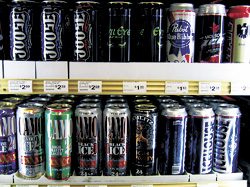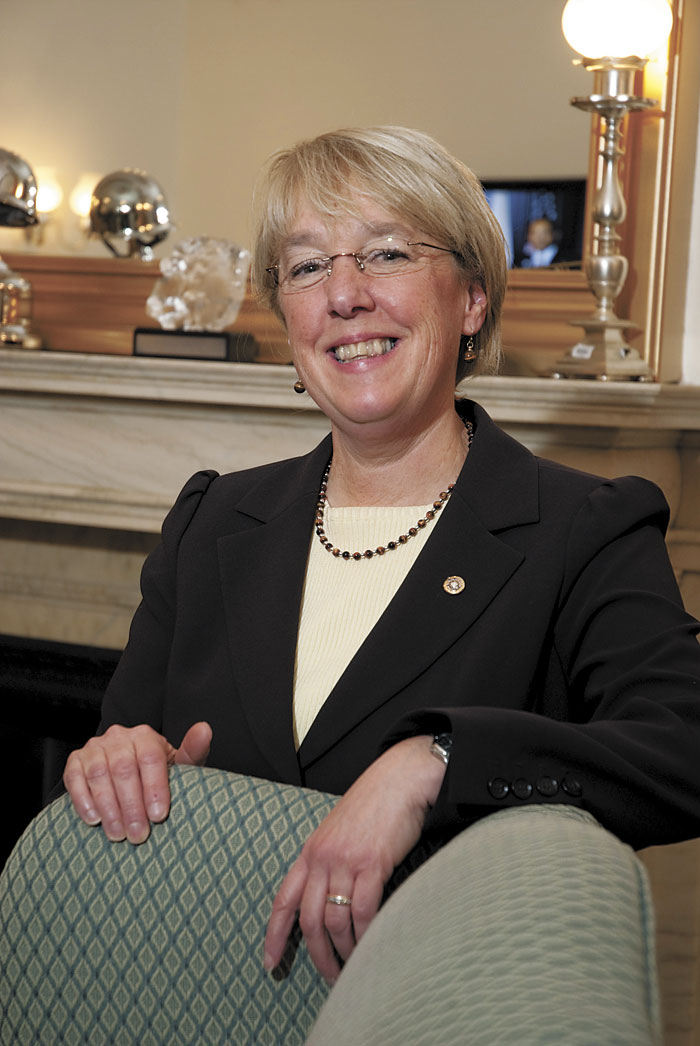Bob Knudson knew something was amiss when he started finding tall, empty cans on the street with curious names like Camo, Max Ice, and Joose, each containing alcohol levels of up to 10.5 percent.
In 2006, Knudson, who’s lived on Capitol Hill for 28 years, fought to make his neighborhood what the State Liquor Control Board calls an Alcohol Impact Area, where sales of specific high-alcohol-content beverages are banned. That year, the City Council voted to make most of Downtown, Belltown, the Central District, the International District, Capitol Hill, and the University District free from a handful of cheap, potent favorites like Colt 45 Ice, Red Dog, and Special 800 Reserve. (Pioneer Square was established as the city’s first AIA in 2000.)
The goal of AIAs is to help diminish public inebriation, and the list of banned products includes 29 malt beverages, ice beers, and fortified wines. But less than 18 months later, beer barons have done the predictable by creating products that aren’t currently prohibited. Though most of the new names showing up in corner-store coolers aren’t made by companies that currently have products banned, the result is the same: The list that took the city years to create is no longer worth the paper it’s written on.
“There was the occasional mention that this could happen,” says Knudson. “But there wasn’t as much talk as there should’ve have been. Maybe the legislation could’ve been written in a different way. I guess people were hoping for the best.”
Jordan Royer, a former staffer for Mayor Greg Nickels who served as the city’s AIA point person, says the pitfalls of outlawing specific products were part of the discussion. “We went back and forth between whether it should be a formula-based approach or a product-based approach, and, frankly, a formula-based just got too complicated,” he says, adding that no one could agree on parameters for cost, size, or alcohol content. The concern was that the net cast would be too wide and could include, for example, specialty shops that sell imported beer.
So Seattle officials did an inventory of empties on the street to determine the most popular high-octane tallboys. In the end, they basically copied Tacoma, Royer says, banning the same list of beverages the city to the south outlawed in 2001.
But the list was never meant to be “written in stone,” Royer insists. Indeed, there is a process for expanding it. The city can make a formal request to the Liquor Control Board, which then must vote to approve the addition of new beverages. Seattle has yet to file such a proposal, although it likely will in the next few weeks as part of a report, due in March, that’s required by statute to evaluate AIA effectiveness.
Doug Carey, the head of the mayor’s public safety team, says he’s received requests from five neighborhood groups to have various new products added to the list. This also happened in Tacoma early on, says Tacoma police officer Greg Hopkins. The city had to add new brand names to its list shortly after its ban was approved. After that, Hopkins says, they had a sit-down with distributors.
“What I’d tell Seattle is that you need to find out who your distributors are and explain to them what they need to do,” he says. “We realized we would keep having to go back over and over again if we didn’t go back to them and explain the intent. You can’t just ban products and walk away from it.”
Still, at least one of the new products, Joose, is now being sold in Tacoma too. Bob Stevens, senior vice president of sales at Alaska Distributors Co. (the company that handles the Joose account in both Seattle and Tacoma), says banning products by name was a bad idea from the start. “It simply provides opportunity for innovation. As long as you go brand by brand, the list is always going to be out of date.”
Joose has been around for the better part of a year, Stevens says, adding that he won’t deny its appeal to the “target audience” (i.e., transient drunks). However, he says it’s also popular with “young, preppy students” as a party starter. Nonetheless, he won’t be surprised if it’s soon forbidden: “The minute it hits the list, we’ll take it out of the accounts that are in the Alcohol Impact Area.”
At City Market on Capitol Hill one morning, Cain Morehead unpacks dry goods in the shadow of a cooler stocked full of row upon row of the new malt liquor brands. Morehead, who’s managed the popular neighborhood grocery for seven years, is resigned to the fact that, with or without a banned list, companies are going to make high-alcohol beverages and people are going to buy them. After he took the old-school buzz-inducers off the shelves, Morehead says, his homeless customers “switched to Bud….Now they’ve switched back.”
Morehead says City Market sells the stuff because otherwise they would lose business to stores that do, but he adds that they try to be a “good neighbor” by only allowing people to purchase one can at a time and by not letting them loiter in front of the store.
Up the street, another store owner, who declined to give her name for fear of upsetting distributors, says she’s disturbed by the appearance of the new beverages: “The ban got rid of them, then the companies made new ones, and they’re stronger. It’s ridiculous. A lot of homeless people just look at the percentage of alcohol. If it’s higher, they buy it.”
One new product, “Bootlegger,” actually comes in a small, glass, flask-shaped bottle with 12 percent alcohol content—and in flavors like grape and green apple. But not everyone sells it. At Dan’s Belltown Grocery on Third Avenue and Blanchard Street, you can buy a single tallboy, but you won’t find any that contain more than 7 percent alcohol; those were pulled off the shelves years before the city council passed the 2006 ban.
“We’ve tried to do everything we can to deter that element,” says manager Ed Peters. Dan’s is located next to what was once called “Crack Park” by the locals. It’s now an off-leash dog area that attracts canines and their owners from surrounding condos, but a nearby bus stop still serves as a gathering place for addicts.
Peters may not sell beers like Joose, but he’s well aware of the new generation of high-alcohol products—he calls it the “under-the-radar resurgence”—and sympathizes with the smaller, independent stores that have to sell the fortified stuff to compete. But Royer, now the government affairs manager at the Pacific Merchant Shipping Association, scoffs at the notion that owners are somehow powerless. “At some point it becomes a personal choice,” he says. “[The city] can’t ban everything.”
Until the recent influx of new brands, Knudson, the Capitol Hill resident, thought the government-mandated ban was working. He’d noticed less littering and human excrement on the street, and fewer instances of people passed out in his yard—the personal barometer of anyone who lives a block off Broadway.
If banning specific products is the policy, Knudson says, there should be a way to expedite the process of adding names to the list. Though Knudson says his efforts in this area have been mired in bureaucracy thus far, City Council member Tom Rasmussen has promised to meet with industry representatives, whom he accuses of playing “Whack-A-Mole games with Seattle” by bringing in beverages not on the list.
“It’s very troubling,” Rasmussen says. “The liquor industry says they want to work with the city to minimize problems, but if they’re just creating new packages for problem-type alcohols, that’s very disappointing, and it really affects their credibility.”
Knudson says he’s hopeful the state and the city will act. Otherwise, he says, “I will have somebody asleep in my yard by spring.”







